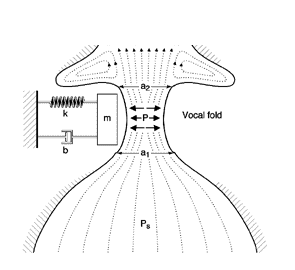Myoelastic Arodynamic Theory
Myoelastic Arodynamic Theory
Myoelastic aerodynamic theory of phonation:
Myo = muscle, elastic = elasticity, aerodynamic = air pressures and flows (Bernoulli principle)
Myoelastic-aerodynamic Theory
Early voice researchers in the 1950's and 1960's explained vocal fold oscillation with the myoelastic-aerodynamic theory. According to these theories, Bernoulli forces (negative pressure) cause the vocal folds to be sucked together, creating a closed airspace below the glottis. Continued air pressure from the lungs builds up underneath the closed folds. Once this pressure becomes high enough, the folds are blown outward, thus opening the glottis and releasing a single 'puff' of air.
The lateral movement of the vocal folds continues until the natural elasticity of the tissue takes over, and the vocal folds move back to their original, closed position. Then, the cycle begins again. Each cycle produces a single small puff of air; the sound of the human voice is nothing more than tens or hundreds of these small puffs of air being released every second and filtered by the vocal tract.
Let's further examine the myoelastic-aerodynamic theory. Myo- means muscle; the vocal folds, after all, are mostly comprised of muscle tissue. The -elastic suffix serves to remind us that the vocal fold is elastic and that we have active control over its elastic properties. Aerodynamic means that the theory deals with the motion of air and other gaseous fluids, and with the forces active on bodies in motion (such as the vocal folds) in relation to such fluids.
A depiction of this simple system is shown below:

A simple rectangular block represents one vocal fold. A spring is useful for portraying the tissue stiffness or restoring force in the vocal fold. Finally, we've added a damping constant to represent the viscosity (energy absorption) of the tissue. The damping constant is similar to the shock absorber on a car or a tubular damper on a screen door.
So, how well does this simple model explain how the vocal folds sustain oscillation? Not well at all, researchers have found. Bernoulli forces alone cannot account for continual energy conversion from airstream to tissue. Soon, oscillation would damp out.
Reference
http://www.ncvs.org/ncvs/tutorials/voiceprod/tutorial/model.html
Schutte, H. K. & Jw. Van den Berg (1980). The Efficiency of Voice Production [Abstract]. Folia Phoniatrica